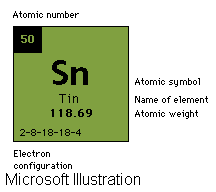


Tin, symbol Sn, is a metallic element that has been used by people since ancient times. Tin is in group 14 of the periodic table. It's atomic number is 50.
Tin is highly ductile and malleable at a temperature of 100° C. It is attacked by strong acids. Ordinarily a silver-white metal, at temperatures below 13° C it often changes into an allotropic form known as gray tin, which is an amorphous, grayish powder. Because of the mottled appearance of tin objects undergoing this decomposition, the action is commonly referred to as tin disease or tin pest. Ordinary bar tin, when bent, issues a crackling sound called tin cry, caused by the friction of the tin crystals.
Tin ranks 49th in abundance of the elements in the earth's crust. Ordinary tin melts at about 232° C, boils at about 2260° C and has an atomic weight of 118.69.
Tin ore comes mainly in the form of mineral cassiterite SnO2, found abundantly in Cornwall, England and in Germany, the Malay Peninsula, Bolivia, Brazil, and Australia. In the extraction of tin, the ore is first ground and washed to remove all impurities and then roasted to oxidize the sulfides of iron and copper. After a second washing, the ore is reduced by carbon in a reverberatory furnace; the molten tin that collects on the bottom is drawn off and molded into blocks known as block tin. In this form, the tin is resmelted at low temperatures; the impurities form an insoluble mass. Tin may also be purified by electrolysis.
Tin is a widely sought metal and is used in hundreds of industrial processes throughout the world. In the form of tinplate, it is used as a protective coating for copper vessels, material for the manufacture of tin cans. Tin is important in the production of the common alloys bronze (tin and copper) and solder (tin and lead). It is also used as an alloy with titanium in the aerospace industry and as an ingredient in some insecticides. Stannic sulfide, known also as mosaic gold, is used in powdered form for bronzing articles made of plaster of paris or wood. The United States imports more than one-fifth of the average annual world production of tin. Most of the world's tin is produced by Malaysia, Brazil, Indonesia, Thailand, Bolivia, and Australia.
Adapted from Microsoft Encarta '97 (tin)
HOMEPAGE | TIN MINING PAGE | USES OF TIN | HISTORY OF TIN | METHODS OF MINING | CASE STUDY | MINING HAZARDS | WASTELAND RECOVERY